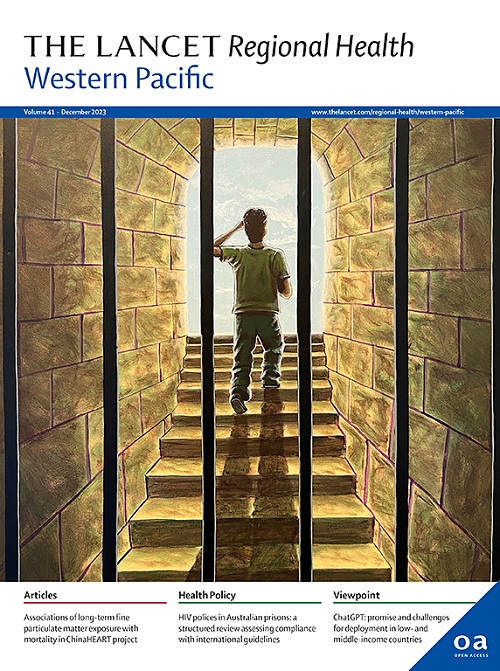Intergenerational association of adverse childhood experiences and perinatal mental health in adult female offspring: evidence from the longitudinal grandmothers, mothers, and their Children's health study in China
IF 8.1
1区 医学
Q1 HEALTH CARE SCIENCES & SERVICES
引用次数: 0
Abstract
Background
The cycle of maltreatment theory posits a linkage between mothers' and offspring's exposures to adverse childhood experiences (ACEs), and their associations with offspring's early-life mental health; however, such associations in adulthood remain unclear. This study aims to examine the intergenerational association between mothers' ACEs, offspring's ACEs, and offspring's mental health from pregnancy to three years after childbirth, and to explore the potential pathways.
Methods
We used data on 1931 mother-offspring dyads from the longitudinal Grandmothers, Mothers, and Their Children's Health study in Huai'an city, China. ACEs were retrospectively assessed based on the Childhood Trauma Screener. Offspring's symptoms of anxiety and depression were measured through self-reported diagnoses or symptoms and standard questionnaires (the 7-item Generalized Anxiety Disorder Scale for anxiety and the 10-item Centre for Epidemiological Studies Depression Scale for depression) during pregnancy, one year and three years after childbirth. Logistic regression models were conducted to estimate the associations. The structural equation model (SEM) was used to examine the potential mediating pathways.
Findings
A total of 367 (19.0%) mothers and 271 (14.0%) female offspring reported the history of ACEs. Female offspring of mothers with ACEs also had higher odds of exposure to ACEs (odds ratio [OR] = 3.37, 95% confidence interval [CI]: 2.51–4.53). Mothers' and female offspring's exposures to ACEs were both associated with higher odds of offspring experiencing mental disorders during the perinatal period. For example, female offspring with ACEs had 2.05-fold (95% CI: 1.54–2.72), 2.41-fold (95% CI: 1.75–3.33), and 2.30-fold (95% CI: 1.58–3.33) increased odds of the anxious or depressive symptoms during pregnancy, one year, and three years after childbirth, respectively, compared to offspring without ACEs. Results from the SEM indicated that mothers' ACEs and female offspring's perinatal mental health were linked mainly through the mediation role of female offspring's ACEs.
Interpretation
Mothers' and female offspring's likelihood of exposure to ACEs are intergenerationally associated and are both related to offspring's perinatal mental health. Female offspring's ACEs mediate the association between mothers' ACEs and female offspring's adulthood mental health. Our findings highlight the need for policies to break the cycle of maltreatment and promote women's mental health across multiple generations, in particular through family-based interventions.
Funding
This study was supported by the National Natural Science Foundation of China (72474197), China Medical Board Open Competition Program (21-416), Key Medical Program of Jiangsu Health Commission (ZD2021044), and Huai'an Science and Technology Program (HAB2024039).
不良童年经历与成年女性后代围产期心理健康的代际关系:来自中国祖母、母亲及其子女健康纵向研究的证据
背景虐待循环理论假设母亲和子女接触不良童年经历(ace)之间存在联系,以及它们与子女早期心理健康的关联;然而,这种关联在成年期是否存在尚不清楚。本研究旨在探讨孕期至产后3年母亲、子女的ace与子女心理健康的代际关系,并探讨其可能的途径。方法采用淮安市“祖母、母亲及其子女健康纵向调查”的1931对母子资料。根据儿童创伤筛查对ace进行回顾性评估。在怀孕期间、分娩后一年和三年,通过自我报告的诊断或症状和标准问卷(7项焦虑的广泛性焦虑障碍量表和10项流行病学研究中心抑郁量表)来测量后代的焦虑和抑郁症状。采用Logistic回归模型来估计相关性。利用结构方程模型(SEM)分析了可能的介导途径。结果367例(19.0%)母亲和271例(14.0%)女子代报告有ace病史。母亲有ace的女性后代也有较高的ace暴露几率(优势比[OR] = 3.37, 95%可信区间[CI]: 2.51-4.53)。母亲和女性后代暴露在ace环境中都与后代在围产期出现精神障碍的几率较高有关。例如,与没有ace的后代相比,有ace的女性后代在怀孕期间、分娩后一年和三年出现焦虑或抑郁症状的几率分别增加2.05倍(95% CI: 1.54-2.72)、2.41倍(95% CI: 1.75-3.33)和2.30倍(95% CI: 1.58-3.33)。扫描电镜结果表明,母亲的ace与女性后代的围产期心理健康主要通过女性后代的ace的中介作用存在关联。母亲和女性后代暴露于ace的可能性是代际相关的,并且都与后代的围产期心理健康有关。女性后代的ace在母亲ace与女性后代成年期心理健康之间起中介作用。我们的研究结果强调需要制定政策,打破虐待的循环,促进几代妇女的心理健康,特别是通过以家庭为基础的干预措施。本研究得到国家自然科学基金(72474197)、中国医学委员会公开竞赛项目(21-416)、江苏省卫生健康委员会重点医学项目(ZD2021044)和淮安市科技计划(HAB2024039)的资助。
本文章由计算机程序翻译,如有差异,请以英文原文为准。
求助全文
约1分钟内获得全文
求助全文
来源期刊

The Lancet Regional Health: Western Pacific
Medicine-Pediatrics, Perinatology and Child Health
CiteScore
8.80
自引率
2.80%
发文量
305
审稿时长
11 weeks
期刊介绍:
The Lancet Regional Health – Western Pacific, a gold open access journal, is an integral part of The Lancet's global initiative advocating for healthcare quality and access worldwide. It aims to advance clinical practice and health policy in the Western Pacific region, contributing to enhanced health outcomes. The journal publishes high-quality original research shedding light on clinical practice and health policy in the region. It also includes reviews, commentaries, and opinion pieces covering diverse regional health topics, such as infectious diseases, non-communicable diseases, child and adolescent health, maternal and reproductive health, aging health, mental health, the health workforce and systems, and health policy.
 求助内容:
求助内容: 应助结果提醒方式:
应助结果提醒方式:


